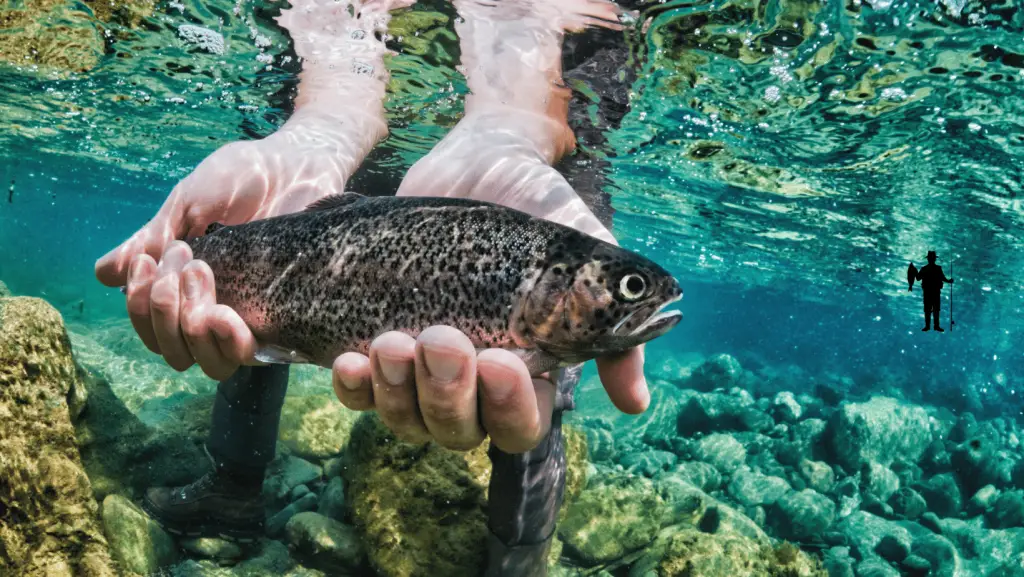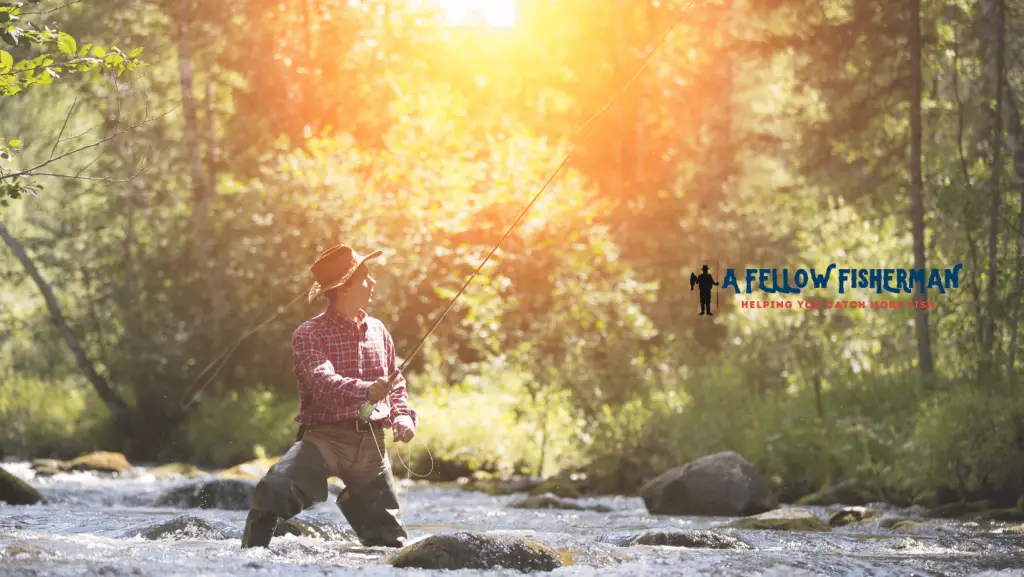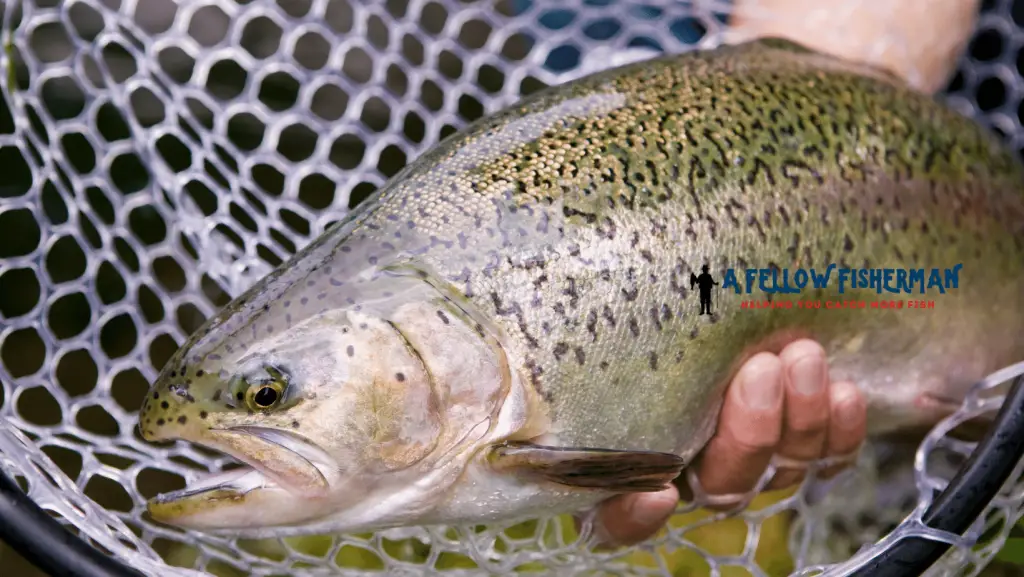
The best answer to the question of what is the best time of day to fish for trout is anytime you can get away, and get on the water.
There are certain times during the day that trout are easier to catch than others, but these awesome gamefish don’t live by the clock as you and I do. Trout react more to temperature, weather conditions, time of the seasons, and light than they do morning, afternoon, or evening.
Best Time of Day For Trout?
Any experienced angler knows the answer to this one. When you arrive at a lake or stream that is supposedly brimming with trout and inevitably doesn’t get a single strike. Then the guy at the marina, or maybe the fishermen working the water a few yards away from you, say, “You should have been here last Tuesday.”
It’s frustrating, but it is often the case when you depend on word of mouth to determine when and where you’re going to try to catch trout.
The truth is that trout will hit any time of the day or night when the other conditions mentioned earlier are in place.
The generic statement that the best time to fish for trout regardless of the season is always from dawn to two hours after sunrise just isn’t true. The other “hot time” claimed to be is from late afternoon, around three hours before sunset to just a few minutes after the sun drops over the western horizon, also not true.
Early morning and late afternoon can be fabulous times to fish for trout, but so can the middle of the day, the middle of the night, and just about any other time of day.
Early Morning Trout Adventure

One morning, my brother-in-law Matt and I set out to do a little trout fishing on Lake Cameahwait, a four-square-mile reservoir in Fremont County, Wyoming. The lake is known by locals as Bass Lake, since large mouth bass are relatively rare in Central Wyoming, and Cameahwait has awesome bass fishing during the summer months. The lake is filled with stocked rainbow and brown trout as well.
We set out with our 16-foot aluminum fishing boat in tow before dawn one morning in June. The lake was as smooth as glass, even the wake of our trolling motor did little to ruffle the placid surface.
With seconds of dropping a Mepps spinner into the water, I had a strike and landed a 13-inch rainbow. As I was reeling in my first fish, Matt set the hook on another rainbow, almost the same size that hit his black Panther Martin spinner.
It was an incredible morning, we had luck on almost every cast. The fishing was so easy we decided to throw everything in the tackle box at these eager fish. They hit every spinner and spoon we had, and we each had several dozen. The only things they didn’t hit were jitterbugs, poppers, and plastic worms.
The secret that day was above the mountains to the north and west of Bass Lake. A thin layer of low-hanging white clouds was dropping a few inches of early summer snow on the Owl Creek and Wind River Mountains on the advancing edge of the low-pressure front.
We pulled off the lake at around 1 p.m. as that mountain snow dropped onto us in the form of light rain.
Low pressure was the key.
My grandfather had a fishing barometer that he relied on religiously to decide whether he would fish or not. If the pressure was dropping, and he had the time, it was off to the water.
Interstate 80 Trout Fishing in Mid-Afternoon
As a college student at the University of Wyoming, hunting and fishing were a way of life. My roommate Frank and I went out to small lakes, beaver ponds, and streams surrounding Laramie, Wyoming. Whenever we had an open spot in our class schedule, and many times when we didn’t, choosing to skip a class for an afternoon on the water.
Interstate 80 runs through Laramie at 7,200 feet (2,194.56 m) altitude on its course from the east to the west coast.
There is a tiny stream that runs through a viaduct under the four-lane highway a few miles outside of Laramie.
The stream pools up in front of a small dam constructed by a farmer for irrigation water in the summer, and crosses under a bridge on a county road off an exit on I-80.
We drove out around noon one day and fished the stream and the tiny half-acre pond backed up behind the little dam.
We threw spinners, spoons, and worms for about 45 minutes with no luck.
As we were talking about leaving, a fast-moving rainstorm hit us.
We decided to throw a cast a couple more times before getting back to the truck.
As I flipped the bail on my spinning road and turned the crank, my rod tip almost snapped. A fight ensued for the next 10 minutes before I finally pulled in a 21-inch rainbow trout. He hit a green rooster tail spinner just as the rain began to fall.
I hurried to the top of the county road to show Frank my prize. Frank was fishing on the other side of the road, in the little reservoir.
He just grinned at me as he picked up a 24-inch brown trout he’d caught on a worm at exactly the same time. We didn’t realize we both had fish on, with the steadily increasing rain dampening the sound.
The point is, it was a 75-degree afternoon in early May when a storm hit and our fishing fortunes reversed.
A Grand Slam on the Sweetwater River
My son came home from college at Dickinson State University in North Dakota, where he was a track athlete and football player one summer. There wasn’t much in the way of trout fishing in that area of Western North Dakota, so he was eager to get back on the water.
We have friends who own several sections of land along the Sweetwater River. Sections of the Oregon Trail run through their property.
We made the 39-mile drive from our place over the top of Beaver Rim to the Sweetwater River.
It was late morning when we arrived.
The Sweetwater in the flats of eastern Fremont County is a small stream that cuts back and forth across the prairie after it flows off South Pass about 50 miles (80.47 km) to the west.
This was a hiking fishing trip. We carried creels, and small packs with flies, lures, and hooks, and a dozen nightcrawlers each.
The challenge of this type of fishing is crossing the many barbed wire fences, but the electric style of excitement came when we found several prairie rattlesnakes enjoying the late June sun. They felt our vibrations before we saw them and let us know they were there with that buzzing warning that sends chills up your spine.
In the space of the next four hours, we caught over 50 trout each, and at least 25 more suckers.
We didn’t keep any trout that day, but we did keep track of the ones we caught.
Both Brian and I scored a grand slam, as we often call it. To achieve a complete grand slam in Wyoming trout fishing you have to catch a brook trout, rainbow, brown, cutthroat, and golden during a single year.
There were no golden trout on the Sweetwater. Golden’s are high altitude fish, living near the tree line around 9,000 feet (2.74 km). We were fishing at 6,000 feet (1,828.8 m) altitude that day.
I caught a 16-inch rainbow on a yellow and black Panther Martin in one of the deeper eddies in the crook of a cutback. The brown came on a worm I let float under an overhanging section of exposed tree roots under a washed-out undercut. The cutthroats and brook trout hit on everything we threw at them. I only caught the one brown that day, but it made my four-hit afternoon.
Brian did the same, but I’m not sure the combination of spinners, spoons, and live bait he used.
We fished from around 10:30 a.m. to 3 p.m., the absolute worst time of day according to the conventional wisdom, but we slammed the water.
The conditions were perfect with light clouds set against a bright blue sky, a high of about 85 degrees, and bright sunshine lighting up our lures.
Just a few mosquitoes dotted the surrounding air, not much of a hatch was going on so the fish were hungry.
Fishing the Big Wind River at 18 Below Zero(Trout Fishing in Winter)
It was ice fishing season, but we were on open water, not the frozen stuff. Our friend Phil is an avid fly fisherman. He convinced three of us to go with him on a sub-zero fishing adventure just two days before our licenses expired as the new year arrived on January 1.
It’s a little confusing to newcomers, and tourists, but the Wind River flows down from the Wind River Mountains onto the plains of Fremont County where it creates Boysen Reservoir behind Boysen Dam.
As the river exits the dam it is still called the Wind River, but as it approaches the end of Wind River Canyon, a cut it created eons ago, it becomes the Big Horn River. I guess it’s all in a name.
It was cold that afternoon, very cold.
We waited for the temperature to rise a little before we made the 25-mile drive to the Wind River Canyon.
It was 31 below that December morning at 6 a.m., but it had “warmed” up nicely to only 20 below by the time we left for the river.
At the Wind River, it was a balmy -18.
Phil told us to fish with egg sack flies. These flies float just below the surface and mimic fish eggs floating in the water.
It was a bait that made sense. Worms would freeze in the frigid air, and trout wouldn’t expect them in these cold conditions, they wouldn’t be fooled by surface flies either, since nothing hatches when the temperature is below zero.
The egg sacks worked great. We started to tie into some very large trout. Between the four of us, we landed about 20 fish that afternoon, the smallest a four-pound brown, and the largest an eight-pound rainbow that Phil fought for almost 15 minutes.
The only issue we had that afternoon was the tip of our rods freezing over with ice, limiting our casts. If you dipped your rod tip in the water, then cast your fly line, you were able to control the direction of the egg sacks pretty well.
As we reeled the line in, little chunks of ice fell off the line as it left the water and returned to our reels.
Cold, blazing bright sunlight, and a quick afternoon of fishing before it got dark at 5 p.m.
The lesson is that afternoon fishing can be fabulous in the right season, with the right bait.
Conclusion

You can catch trout at any time of the day, but your success depends more on conditions, seasons, and the bait you choose than the time of day.
With all things being equal, early morning just after dawn for a few hours, and late afternoon until sunset. These are good times to fish since in the summer months at least that’s when the caddisflies, mayflies, and other insects swarm most actively. Those swarming bugs attract fish.
Ice fishing for trout is often best in the middle of the night and can be awesome in the middle of the afternoon.
Ice fishing for trout doesn’t follow the rules at all. If you’re night fishing, you’ll want to use live bait, worms, waxworms, or minnows.
In the daytime, jigs work just as well as live bait.
The overall message is that if you pay attention to the weather, the seasons, the hatch, and the style of bait you’re presenting, you can catch trout 24 hours a day, 365 days a year.
For more articles on trout fishing, check out some posts below:










